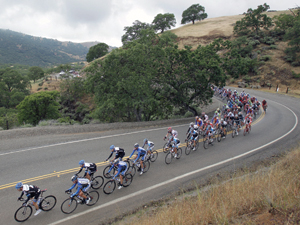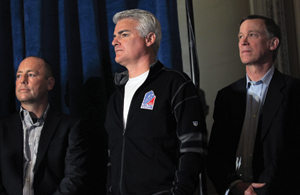Last month, Shawn Hunter marveled at the scene on l’Alpe d’Huez, the Tour de France’s most famous mountain road.
Half a million spectators crammed the eight-mile stretch, and thousands had camped there overnight. Television cameras pointed at each of the 21 hairpin turns.
 |
GETTY IMAGES
The Amgen Tour of California is still climbing the hill toward profitability, sources say. |
Hunter, a former president of AEG Sports and NHL and MLS executive, was less than two months from the debut of his own bicycle race, the USA Pro Cycling Challenge in Colorado.
“It’s hard to share what it’s like, looking at a million spectators standing on a mountainside, with someone else,” said Hunter, who is CEO and co-chairman of the Colorado race. “I thought, if we could only bottle this scene and take it back to Denver, we could show people how exciting bicycle racing can be.”
With an operating budget of $10 million, the eight-day Colorado race that starts next week will be significantly smaller than the 21-day Tour de France, which has an estimated operating budget of $100 million and is thought to net $30 million to $50 million in profit, the majority from TV rights.
But Hunter hopes to recreate the feeling of the French Alps in Colorado. With its inaugural race, the USA Pro Cycling Challenge will become America’s second-largest bicycle event, behind the Amgen Tour of California, which has an operating budget of $12 million, sources said. Many of the same elite cyclists competing in France, including the top-three overall finishers, will also race in Colorado. Every stage of the Colorado race will be shown live on Versus. While Versus’ rights did not include a rights fee, Hunter was able to negotiate international television deals which will bring in combined revenue in the mid-six figure range, sources said.
Sources close to the race say cities hosting the start and finish stages are paying mid-five- to low-six-figure sums to participate. Hunter has developed a sponsorship portfolio that includes Nissan, RadioShack, Waste Management, United Health Care, Kroger, Coca-Cola and Exergy Energy. Sources said sandwich maker Quiznos and burger chain Smashburger, which are owned by race owner Rick Schaden, are contributing $1.5 million each in sponsorship, which is the high end of sponsorship fees.
 |
GETTY IMAGES
Hunter (center) with USA Pro Cycling Challenge owner Rick Schaden and Colorado Gov. John Hickenlooper |
“Our path to eventual profitability comes from growing sponsorship and maximizing international television,” said Hunter, who helped launch the Tour of California while with AEG in 2006.
But the path to profitability is a tall task. For nearly three decades, American executives such as Hunter have attempted to recreate the success of European bicycle racing, and make the business profitable. They organized multiday stage races, such as the Coors Classic, Tour duPont and Tour de Georgia. But due to the inherent challenges posed by the business model of road bicycle racing, these events lasted a fraction as long as the Tour, which was first held in 1903.
In fact, the U.S. has only five races sanctioned by the sport’s international governing body, the Union Cycliste International.
“The consistent failure is due to the same problem. You gotta be willing to lose a lot of money for a long time,” said David Chauner, who started America’s first major international race, Philadelphia’s TD Bank International, which this year celebrated its 27th anniversary. “There is no real revenue model that makes sense.”
Major bicycle races do not generate gate receipts. Television audiences in the United States are growing, but comparatively small to those from the major sports, so lucrative rights fees are not part of the equation. No major American races earn a rights fee for nationwide TV coverage, a source said. Revenue is generated almost entirely by sponsorship dollars, or fees paid by municipalities where the races start and finish.
But bicycle racing reaches a desirable demographic. According to Versus, the median household income is $78,000, the top income figure for any of its sports. And Versus’ Tour viewership has risen 25 percent since 2008.
The United States has three major international stage races — the tours of California and Utah and the USA Pro Cycling Challenge — and three major one-day events. A smattering of domestic pro and amateur races, which are sustained largely by participant entry fees, also exist.
Overhead costs for the major races add up. Riders occasionally charge appearance fees. A race must house and feed the teams, as well as their staff. It must pay out a prize purse that is designated by the UCI. An organizer must also close miles of public roadway, and pay local law enforcement wages to do so. Local politics decides how much communities will give, or charge.
“You’re trying to get as many services from a community as possible,” said Sean Petty, COO of USA Cycling, the national governing body. “Governments in states that are strapped for cash can no longer provide the support that they could a few years ago. It’s become a much harder sell.”
Both the Tour de Georgia, which ran from 2003-08, and Tour of Missouri, which ran from 2007-09, were born out of the state legislatures looking to grow the visibility of their state, and both races folded after changes in administration. The one-day San Francisco Grand Prix, which ran from 2001-05 and operated on a $1.3 million budget, could no longer cover its costs after the city of San Francisco asked the race to pay for $350,000 in police and road services.
According to numerous sources, major American bicycle races often depend on a financial backer whose passion for the sport outweighs the losses in revenue.
“It takes a visionary, it takes a person who believes in the sport and sees what it can give back to the community,” said Jim Birrell, whose Medalist Sports company organizes the operating logistics for the Tours of California and Utah, as well as the Colorado race.
Sources familiar with the Tour of California, which has yet to break even since its debut in 2006, said the race has survived in part due to AEG Founder Phil Anschutz’s affinity for cycling. Title sponsor Amgen, which in early August renewed its mid seven-figure deal for two more years, uses the event to promote its Breakaway from Cancer charity. This is also the case with the Tour of Utah, which is backed by the Larry H. Miller Group. The race, which started in 2004, has slowly grown its operating budget to $2.5 million, sources said, and its evolution has been driven in part by Miller’s son Greg, who is an advocate of health and fitness.
Sources close to the USA Pro Cycling Challenge said race owner Rick Schaden and his father, Rich, have already committed $10 million of their own money to the race. The race declined to make either Schaden available for comment. Hunter said the sponsorship from the race will cover more than half of the operating budget the first year.
Jonathan Vaughters, manager of the Garmin-Cervelo pro cycling team and a former pro rider, said the sport has long relied on wealthy patrons to keep it afloat in the United States. However, he believes the sport should move away from that model.
“In order for the sport to grow, we need to be seen as an investment, and not a donation,” Vaughters said. “Investors want to see the possibility of profitability.” Vaughters said the industry should seek investment from the private equity sector, but should first address problems with doping and instability at the team level.
There are numerous opinions for how the sport can create a profitable model. Several promoters interviewed for this story believe that holding mass-participant events in conjunction with the pro race can generate interest and registration revenue. The 2011 Tour of California featured a 100-mile amateur ride a week before the pro race. Called l’Etape du California, the event attracted 1,000 participants who paid $125 each to participate.
Michael Aisner, who owned and operated the Coors Classic from 1980 until 1988, said races should invest more in retail and merchandise sales. Aisner said that in 1987, the Coors Classic generated $1.5 million in merchandise sales, which covered nearly half the race’s expenses. He also said organizers need to keep their budgets and salaries in check.
“When I ran a race I made a salary that was probably great for a school teacher,” Aisner said.
Chauner believes the key is to keep infrastructure costs down by holding races on smaller courses. He envisions holding a velodrome-style series of races on shorter road courses, which would enable promoters to charge entry fees to spectators. “Shorter criteriums aren’t nearly as expensive to put on, and the racing is more exciting,” Chauner said. “The problem is that everyone is trying to recreate the [Tour de France].”
Hunter believes the key is to find companies willing to make long-term commitments, such as Amgen. A source familiar with the Tour of California said the race’s losses this year were less than $1 million, and predicted the race could even turn a profit in 2012. Hunter believes the USA Pro Cycling Challenge will break even in just three years.
“As our race grows, we’ll see the economic footprint grow, and the rights fees will grow,” Hunter said. “We want to focus on making sure the race will be around for a long time.”






